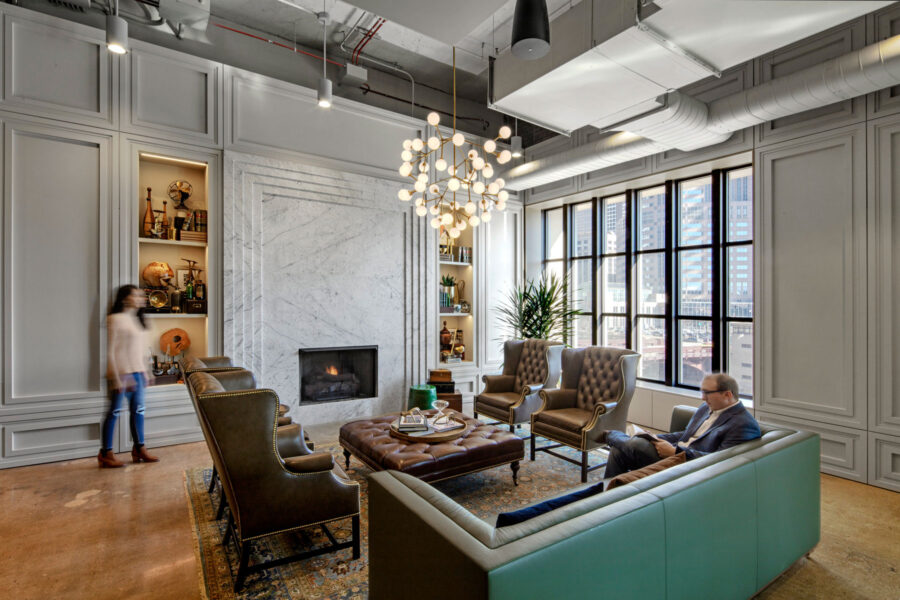Story at a glance:
- Architects are using the Gensler Product Sustainability (GPS) Standards to reconsider materials.
- Gensler released the new material standards, which anyone can access, in early 2024, starting with the most common, high impact product categories—from acoustic ceiling panels and carpet tiles to gypsum board, resilient flooring, and task chairs.
When architects at Gensler see a void in the industry, they don’t waste time; they work to fill it.
“We’re tool-friendly at Gensler. We like to develop not only the industry’s latest and greatest tools, but if we see a need for something, we’ll develop it,” says Stephen Katz, a technical director in Gensler’s Chicago office. “We’re basically trying to have as big of an impact as we can on the market.” Part of that, he says, is developing tools and promoting the ones they feel are most effective.
To streamline the selection of materials that contribute to carbon neutrality, Gensler recently developed the Gensler Product Sustainability (GPS) Standards. The initiative involves rigorous vetting of products based on their environmental impact, ensuring they meet or exceed specific standards. “Getting the right products and materials into a project that can move the needle is really, really challenging,” Katz says.
Gensler released the new material standards, which anyone can access, in early 2024, starting with the most common, high impact product categories—from acoustic ceiling panels and carpet tiles to gypsum board, resilient flooring, and task chairs.

Gensler designed 200 Park Avenue in San Jose, California to be all-electric. Photo by Jason O’Rear
“We’re eventually going to roll that out to even more specifications and products as time goes on,” Katz says. “We’re trying to really change the reporting structure that goes into how we specify and then track all this data. The data can be a little overwhelming, but we think this is a great way to get in front of the market and really have an impact. There are targets, and then there are what you receive for the actual product. We’re trying to establish those targets as early as possible and then monitor them in the later phases.”
At Gensler the work begins with setting up embodied carbon targets in their specifications. These could be for building systems like structural steel or concrete. Then they require embodied carbon EPDs to be submitted for select building materials. “We feel that’s the biggest way we can have an impact on the industry—to essentially lead by example,” Katz says.
Considering buildings are responsible for 40% of greenhouse gas emissions globally, every choice made on a project can make a difference, Katz says. Significant advances also continue to be made in reducing the operational carbon footprint, for example, by moving from fossil fuel sources to all electric.

Gensler was part of a team working to repurpose as much as possible inside the Old Chicago Post Office project. Photo by Eric Laignel
Repurposing as much as possible—buildings and furnishings—is another approach. “I worked with the Old Chicago Post Office and The Mart in Chicago. These are huge buildings,” Katz says. “If you think of the amount of embodied carbon that went into making those structures, it’s enormous. Instead of those buildings being torn down and built anew, the owners were able to leverage the embodied carbon already there and simply renovate and repurpose the building.”
Katz has worked with Gensler for 26 years and says he’s seen a lot of positive growth in that time. “The firm has a really deep social conscience, and that’s driven by the leadership,” he says. “It’s been really wonderful to be a part of that over the years. I think of the opportunities I’ve had to work and grow within the firm, and I think of those conversations about sustainability and how that’s changing. There’s a lot of excitement from our younger staff, too, who really understand that mission statement. They don’t have to be sold on it, and that’s the kind of joy we see having an impact on the market.”
Sustainable Materials at Work

The Gensler-designed 200 Park Avenue features outdoor terraces at every level, coupled with wellness-oriented amenities that allow occupants to balance work and self-care. Photo by Jason O’Rear
At 200 Park Avenue Gensler worked with client Jay Paul Company to design a fully electric, 19-story office tower in an underdeveloped corner of downtown San Jose, California. Katz was part of the project team that emphasized sustainable materials at every turn, as the tech-oriented office tower brought the energy and identity of Silicon Valley to downtown San Jose’s urban core.
Gensler calls the project bold and optimistic, with an eye toward the future. “Solar canyons” redefine the cityscape and change the way people experience their workspace, while natural light, open spaces, and incredible views are a breath of fresh air. The building features outdoor terraces at every level, coupled with wellness-oriented amenities that allow occupants to balance work and self-care. “It turned out amazing,” Katz says. “It’s got a really dynamic facade.”
To control solar heat gain, the team adjusted the window-wall ratio based on each elevation’s solar exposure. The south and west facades, receiving the most sunlight, feature more insulated opaque panels and less vision glass. The glass is also angled away from the sun’s intensity.
Going all-electric was one of Gensler’s first ambitious sustainability goals at 200 Park Avenue. By committing to the all-electric mechanical system, they achieved a 73% reduction in greenhouse gas emissions compared to traditional gas boilers. This also ensured the building could be fully powered by renewable energy as the grid becomes greener.
“It’s definitely going to take a big effort in terms of understanding how to get from point A to point B,” Katz says of the journey to greener building. “There’s an old saying that if you can measure it, you can manage it, so we really want to understand how we measure the targets and how we measure what we’re seeing and actually being built.”
GPS Standards product categories include:
- Acoustic Ceiling Panels, Tiles, and Suspension Grids
- Batt Insulation
- Board Insulation
- Carpet Tile
- Decorative Glass
- Glass Demountable Partitions
- Gypsum Board
- Interior Latex Paint
- Non-Structural Metal Framing
- Resilient Flooring and Base
- Systems Furniture Workstations
- Task Chairs




